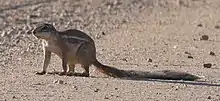Mountain ground squirrel
The mountain ground squirrel (Geosciurus princeps)[2] is a rodent that is native to southwestern Angola, western Namibia, and western South Africa.[3] It is also known as the Kaoko ground squirrel or the Damara ground squirrel.
| Mountain ground squirrel | |
|---|---|
 | |
| Scientific classification | |
| Domain: | Eukaryota |
| Kingdom: | Animalia |
| Phylum: | Chordata |
| Class: | Mammalia |
| Order: | Rodentia |
| Family: | Sciuridae |
| Genus: | Geosciurus |
| Species: | G. princeps |
| Binomial name | |
| Geosciurus princeps (Thomas, 1929) | |
| Synonyms | |
|
Xerus princeps | |
It is the closest relative of the Cape ground squirrel[4] (Latin name Geosciurus inauris), which is so similar in appearance that the two are difficult to distinguish in the field.[5] Both species have long bushy black and white tails with a white stripe from the shoulder towards the rump. Geosciurus princeps is slightly larger, on average, than G. inauris, although there is considerable overlap in body size. Differences in skull morphology also distinguish the two species,[6] and the incisors are yellow to orange rather than white as in G. inauris.[6][7]
Distribution
The mountain ground squirrel is restricted to a narrow band of the southwest arid region of Africa from southern Angola to southern Namibia and as far south as Richtersveld National Park.[5]
Description
The mountain ground squirrel is a large-bodied squirrel with small ears. The total length of head and body measures 23 to 29 cm (9.1 to 11.4 in),[8][9] tail length from 21 to 28 cm (8.3 to 11.0 in),[8][9] and weight ranges from 490 to 710 grams (1.1 to 1.6 lb).[3] The body is covered in short, pale cinnamon brown hair, which changes to white on the belly, around the eyes, and on the front of the face. A white stripe extends from shoulders to hips. There is no underfur, and the skin is black. Tail hairs are white with three black stripes.[7]
Behavior
Mountain ground squirrels are strictly diurnal. Adult females may live alone or in small family groups, while males are mostly solitary.[5] In contrast to the Cape Ground Squirrel, they are not known to exhibit play behaviors, allogrooming, or other social behaviors.[5] They build burrows in areas with sparse cover. In the daytime, they may range up to 1 km (0.6 mi) from the home burrow in search of food.[5]
References
- Griffin, M. & Coetzee, N. (2008). "Xerus princeps". IUCN Red List of Threatened Species. 2008. Retrieved 8 January 2009.
- "Explore the Database". www.mammaldiversity.org. Retrieved 17 August 2021.
- Waterman JM, Herron MD (2004). "Xerus princeps". Mammalian Species. 751: 1–3. doi:10.1644/751.
- Herron MD, Waterman JM, Parkinson CL (2005). "Phylogeny and historical biogeography of African ground squirrels: the role of climate change in the evolution of Xerus". Molecular Ecology. 14 (9): 2773–2788. doi:10.1111/j.1365-294X.2005.02630.x. PMID 16029477. S2CID 35874572.
- Herzig-Straschil B, Herzig A (1989). "Biology of Xerus princeps (Rodentia, Sciuridae)". Madoqua. 16: 41–46.
- Herzig-Straschil B, Herzig A, Winkler H (1991). "A morphometric analysis of the skulls of Xerus inauris and Xerus princeps (Rodentia; Sciuridae)". Zeitschrift für Säugetierkunde. 56: 177–187.
- Thomas, O (1929). "On mammals from the Kaoko-Veld, south-west Africa, obtained during Captain Shortridge's fifth Percy Sladen and Kaffrarian Museum expedition". Proceedings of the Zoological Society of London. 106: 99–111. doi:10.1111/j.1469-7998.1929.tb07691.x.
- de Graaf, G (1981). The Rodents of Southern Africa. Durban, South Africa: Butterworths. ISBN 978-0-409-09829-7.
- Shortridge, RV (1934). The Rodents of South West Africa. London: Heinemann.
External links
- Kruger Park page on the Mountain Ground Squirrel
- Uniprot taxonomy page on Geosciurus princeps
- Thorington, R. W. Jr. and R. S. Hoffman. 2005. Family Sciuridae. pp. 754–818 in Mammal Species of the World, a Taxonomic and Geographic Reference. D. E. Wilson and D. M. Reeder eds. Johns Hopkins University Press, Baltimore. ISBN 978-0-8018-8221-0
